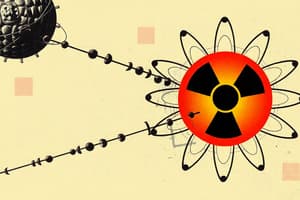Podcast
Questions and Answers
What aspect of the atom did Rutherford's model first suggest?
What aspect of the atom did Rutherford's model first suggest?
- The cloud-like distribution of protons
- The consistent size of the electron orbits
- The scattering of electrons around the nucleus
- The existence of a small, dense nucleus (correct)
Which experimental evidence directly supported Rutherford's nuclear model of the atom?
Which experimental evidence directly supported Rutherford's nuclear model of the atom?
- Observations during the gold foil experiment (correct)
- The existence of electron clouds
- Behavior of electrons in alpha particles
- Interactions with beta particles
What was a significant limitation of Rutherford's atomic model?
What was a significant limitation of Rutherford's atomic model?
- It failed to explain the stability of atoms (correct)
- It incorrectly described electron orbits
- It did not account for the presence of electrons
- It overlooked the existence of protons
How did Rutherford's nuclear model contribute to our understanding of atomic science?
How did Rutherford's nuclear model contribute to our understanding of atomic science?
Which subsequent scientific advancement addressed the limitations of Rutherford's model and provided a more accurate description of electron behavior?
Which subsequent scientific advancement addressed the limitations of Rutherford's model and provided a more accurate description of electron behavior?
What did Rutherford's model propose about the distribution of mass and charge in an atom?
What did Rutherford's model propose about the distribution of mass and charge in an atom?
How did Rutherford's model differ from Thomson's model regarding the distribution of electrons in an atom?
How did Rutherford's model differ from Thomson's model regarding the distribution of electrons in an atom?
What is the significance of the gold foil experiment in the development of atomic theory?
What is the significance of the gold foil experiment in the development of atomic theory?
What was observed when alpha particles were bombarded at the gold foil in Rutherford's experiment?
What was observed when alpha particles were bombarded at the gold foil in Rutherford's experiment?
In Rutherford's gold foil experiment, what did the observation of some alpha particles undergoing dramatic deflections suggest?
In Rutherford's gold foil experiment, what did the observation of some alpha particles undergoing dramatic deflections suggest?
Study Notes
Rutherford Model of the Atom: Unlocking the Nuclear Era
In the early 20th century, British physicist Ernest Rutherford revolutionized our understanding of atomic structure with his groundbreaking model. This model, now known as the Rutherford model, shed light on the fundamental building blocks of matter and paved the way for the modern quantum mechanical view of the atom.
Atomic Structure
Rutherford postulated that atoms consist of a dense, positively charged nucleus surrounded by orbiting electrons. This idea challenged the then-dominant Thomson model, which proposed that electrons were dispersed throughout the atom like raisins in a pudding. Rutherford's model showed that the vast majority of an atom's mass and positive charge reside in the nucleus, while the electrons were relatively tiny and light, orbiting the nucleus much like planets orbiting the sun.
Gold Foil Experiment
Rutherford's model was borne out of a series of experiments conducted in 1909 and 1911, known as the gold foil experiment. In this experiment, Rutherford and his team bombarded extremely thin sheets of gold with alpha particles, which are helium nuclei ejected from radioactive substances. They observed that the majority of alpha particles passed through the gold foil with minimal deflection. However, a small fraction of these particles underwent dramatic deflections or were even reflected back at the experimenters. These results were consistent with what we would now call a nuclear collision.
Nuclear Model
From these results, Rutherford derived a nuclear model of the atom, where the positively charged nucleus existed at the center of the atom, and electrons were scattered around it in orbits. This model provided an explanation for the observed behavior of atoms, particularly when it came to their interactions with radiation like alpha particles.
The Rutherford model was the first to suggest that the atom consists of a small, dense nucleus and a cloud of electrons. Though it was later found to be an oversimplification, it laid the groundwork for our modern understanding of the atom, and Rutherford's model is characterized as a key milestone in the history of atomic science.
In the coming years, further experiments and discoveries would lead to a more complete understanding of atomic structure, in particular, the development of quantum mechanics, which would resolve many contradictions and provide a more accurate description of the behavior of electrons in the atom. Nevertheless, Rutherford's model remains a seminal contribution to the field of atomic science and the basis for our understanding of nuclear physics.
Studying That Suits You
Use AI to generate personalized quizzes and flashcards to suit your learning preferences.
Description
Test your knowledge on the Rutherford model of the atom, which revolutionized atomic science in the early 20th century. Learn about the atomic structure proposed by Ernest Rutherford and the gold foil experiment that led to the development of the nuclear model.




